| Article ID | Journal | Published Year | Pages | File Type |
|---|---|---|---|---|
| 1450718 | Acta Materialia | 2005 | 11 Pages |
Three-dimensional atom-probe tomography, transmission electron microscopy and microhardness were used to investigate the temporal evolution of nanosize, coherent Al3(Sc1−xTix) precipitates (L12 structure) in a coarse-grained Al–0.06at.%Sc–0.06at.%Ti alloy aged between 300 and 450 °C. At 300 °C, most scandium atoms partition within one day to the precipitates, whereas titanium atoms, even after 64 days of aging, remain predominantly in solid solution in the matrix, resulting in precipitates with average composition Al3(Sc0.94Ti0.06). While titanium is very effective at retarding the coarsening kinetics of the precipitates, the low levels of titanium substitution result in only modest hardness increases over the binary Al–0.06at.%Sc alloy. When crept at 300 °C, the peak-aged alloy exhibits a threshold stress, which when normalized by the Orowan stress, increases with increasing radius, as predicted by a recent model considering elastic interactions between dislocations and coherent precipitates, and as previously observed in Al–Sc–Zr alloys.
